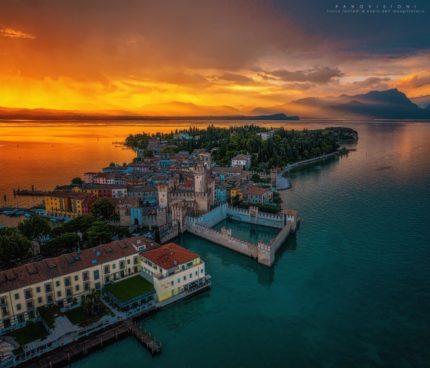
Courtesy of Vigneto Communications
It’s time to discover Lugana — one of Italy’s best kept wine secrets. It’s a tiny region that is only seven miles wide yet makes some of the country’s most elegant and nuanced white wines.

Courtesy of Vigneto Communications
And, I never knew it existed. The area is better known for Lake Garda, the largest lake in Italy, lined with towns and offering activities like boat rides, beaches, Roman ruins, swimming, golf and trails. But focusing just on tourism is a mistake. This is a spectacular find of mineral-driven, elegant and flavorful wines that go well with food and offer amazing values.
Discover Lugana

Courtesy of Vigneto Communications
We originally had a trip scheduled to other towns in Italy but had to go virtual due to the pandemic. It was easy to imagine walking through the vineyards on a journey of discovery of a new region. Susannah Gold, who is one of only a handful of non-Italians in the Associazione Italiana Sommeliers (AIS), was our guide through #winestudio and began our introduction to the Consorzio Tutela Lugana
Denominazione di Origine Controllata (DOC) system. The DOC was introduced in 1963 and is defined by its terroir, its dense soil with white clays and limestone, micro-climate, quality and production methods.
Discover Lugana

Courtesy of Vigneto Communications
These white wines are made from the Turbiana grape, which is native to Italy, grown near the lake and also known as Trebbiano di Lugana. The region borders Veneto and Lombardy and covers five towns: Peschiera del Garda in Veneto, and Desenzano, Sirmione, Pozzolengo and Lonato in Lombardy. There are more than 120 members of the Consorzio Tutela Lugana DOC who offer five Turbiana styles: Vintage, Superiore (aged a year), Riserva (aged two years), Spumante and Late Harvest.
Discover Lugana
You won’t believe the values – ranging from $9 to $25 – and the styles, which ranged from citrus to stone fruit to almond to herbal notes with a beautiful minerality and salinity. These wines can age for two to three years, while Superiore and Riserva selections can develop well for several years or more and the food pairings are diverse – cheese, chicken, Asian, Indian and pizza.
Today, most producers vinify in stainless steel with prolonged skin contact on the lees. For Superiore and Riserva bottlings, many producers age in both steel and wood to lend complexity. The name appears to derive from the early-medieval word “lucus” (“a wood”). This zone was covered by the Selva Lucana, a dense and marshy forest. But the presence of vines in this area dates back to Bronze Age and is proven by the famous Vitis Silvestris grape seeds found around the pile dwellings of Peschiera del Garda.
The good news is that the United States is Lugana’s fourth-largest export market. The bad news is that a quick search in Dallas finds that it is quite the unicorn to find.

Every wine I tried was unique and different. Here was my sample line-up and every writer received a different assortment (note that some of the links are tough to navigate, but I wanted to give you a source for these wines):
2018 Colli Vaibo – the Colli Vaibo wines have been produced for three generations of family and is produced today by Gianfranco and Diego. It is a great wine to enjoy on a hot Texas Summer day with lots of minerality, stone fruit, green apple, herb and citrus.
2018 Tenuta Roveglia Limne — The Tenuta Roveglia story dates back to 1404 when the Roveglio family purchased lands and farmhouses from the monastery of San Salvatore in Brescia. At the end of the nineteenth century, Federico Zweifel, left the Canton of Glarus in the heart of Switzerland, where he was born, in order to find better working conditions in Italy. He settled in Lake Garda and found an ideal site for a vineyard where he transformed abandoned fields and several generations later the family started making wine.
I tasted notes of tropical fruit, pear apricot and citrus notes. Lots of fruit, minerality and tanginess.
2018 Sgreva Sirmio – Azienda Agricola Sgreva is a 50-year family winery located in the city of Sirmione owned by two brothers, Giacomo and Vanessa, and their mother, Francesca. The winery is 18 hectares and the family believes that good, genuine wine and quality come first from the vineyard.
I tasted notes of baked bread, tropical fruit, apple, pear with a bit of bitterness at the end that worked. It was an elegant wine – refreshing and delicious.
2017 Cà dei Frati – I had tasted the winery’s flagship wine before and really enjoyed it but knew nothing about the region or story behind it. Ca’ dei Frati has been around since 1782, known as the “place of the Friars”. In 1939, Felice Dal Cero, a former wine grower realized the potential and moved to the area. After thirty years working in the vineyard and the cellar, his son Pietro worked to help create the DOC in 1969, bottling his first wine with the label Lugana Casa dei Frati, later named Ca’ dei Frati, which is still run by the family today.
So much was happening in the glass with notes of basil, tropical fruit, toast, peach, almond, and citrus.
My discovery of Lugana yielded five key takeaways:
1. Every wine was unique and different (and I loved every one I tried)
2. They are currently hard to find in Dallas
3. The price point is incredible – $9 to $25 – a great value!
4. I need to find the spumante and the dessert wines and try them.
5. I am so happy to have discovered this region through Wine Studio.



